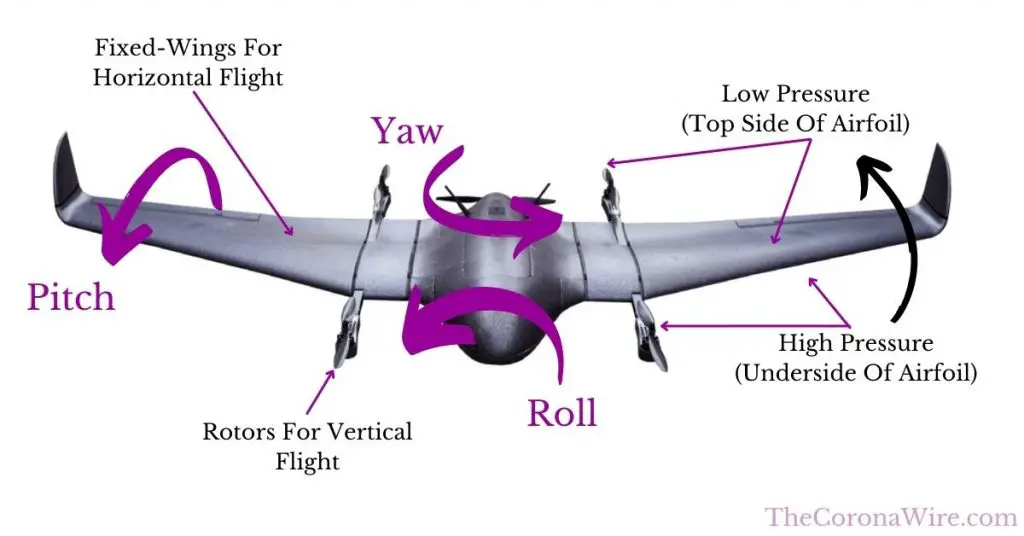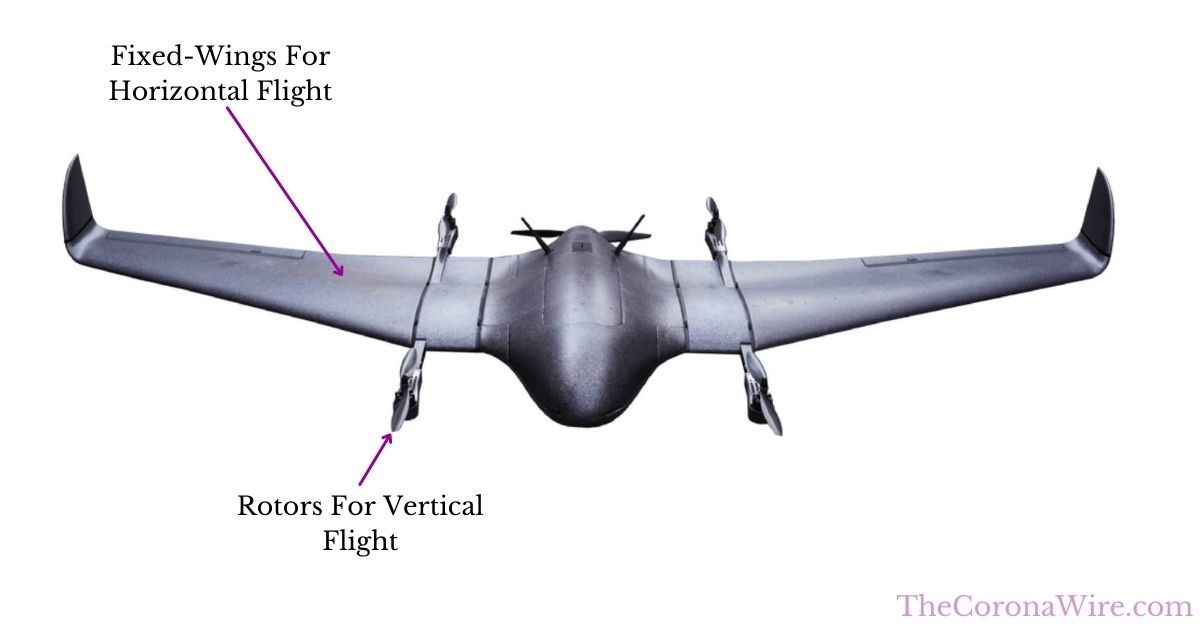Fixed-wing UAV and rotary-wing UAVs are two of the most popular drone designs. They both have incredible benefits and fewer drawbacks compared to other types of drones.
The hybrid fixed-wing/vertical takeoff and landing (VTOL) design uses features found in both of these designs and attempts to blend them together in an efficient and effective way that theoretically eliminates the drawbacks found in each of the individual designs.
What are hybrid fixed-wing/VTOL UAVs?
Hybrid fixed-wing/vertical takeoff and landing (VTOL) UAVs are drones that can operate in both vertical flight for takeoff and landing and horizontal flight once in the air. They are hybrids between fixed-wing UAVs and rotary-wing UAVs, incorporating both fixed wings and propellers in their designs.
Take note that hybrid fixed-wing/VTOL UAVs are often also simply called hybrid VTOL drones.
- How Do Hybrid Fixed-Wing/VTOL UAVs Work?
- What Are The Types Of Hybrid Fixed-Wing/VTOL UAVs?
- What Are Hybrid Fixed-Wing/VTOL UAVs Used For?
- What Parts/Components Make Up Hybrid Fixed-Wing/VTOL UAVs?
- What Are The Advantages And Disadvantages Of Hybrid Fixed-Wing/VTOL UAVs?
- Hybrid Fixed-Wing/VTOL UAV Powerplants & Propulsion Devices
- What Are Some Examples Of Hybrid Fixed-Wing/VTOL UAVs?
- Conclusion
How Do Hybrid Fixed-Wing/VTOL UAVs Work?
Hybrid fixed-wing/vertical takeoff and landing (VTOL) UAVs incorporate features from both the fixed-wing and rotary-wing drone designs. Each of these designs have their own capabilities, benefits and drawbacks.
In order to fully understand how hybrid fixed-wing/VTOL drones work, you need to understand how fixed-wing UAVs and rotary-wing UAVs work.
Fixed-wing UAVs use wings/airfoils that are sized and shaped in a way that captures the flow of air as the aircraft’s airspeed increases which thus produces lift. Typically, the longer these wings are, the more efficient they are as they can catch more airflow as long as the wing’s weight does not increase.
Check out our full post that dives further into how fixed-wing UAVs work, the differences between fixed-wing and rotary-wing UAVs, fixed-wing drone applications, parts/components that make them up, advantages/disadvantages, powerplants used in them and some real examples:
Related Post: What Are Fixed-Wing Drones/UAVs? Everything You Need To Know
Rotary-wing UAVs use one large main spinning rotor (typically with an anti-torque device/tail rotor) or multiple smaller rotors all spinning at a rapid speed. The propellers act as small airfoils capturing airflow and generating lift. The direction of the UAV can be changed by altering the angle of the prop/s.
Hybrid fixed-wing/vertical takeoff and landing (VTOL) drones/UAVs takeoff and land vertically using rotors/propellers, and transition into horizontal flight using their fixed wings once they’ve reached a suitable height.

Some types of hybrid fixed-wing/VTOL UAVs activate and deactivate certain features while transitioning from one flight mode to another, and others don’t need to.
Check out our full post on the types of hybrid fixed-wing/VTOL UAVs:
Related Post: Types Of Hybrid Fixed-Wing/VTOL UAVs Explained (+Pictures)
Propellers that are used for both vertical flight and horizontal flight are called proprotors. Several types of hybrid fixed-wing/VTOL UAVs use proprotors such as tiltwing, tiltrotor, and tail-sitter UAVs.
What Are The Types Of Hybrid Fixed-Wing/VTOL UAVs?
Hybrid fixed-wing/VTOL UAVs can come in several different types. Each of these types may have different numbers of rotors and may operate in different ways.
Here are the two types of hybrid fixed-wing/VTOL UAVs:
- Convertiplanes
- Tail-sitter UAVs
Convertiplanes are hybrid fixed-wing/VTOL unmanned aerial vehicles (UAVs) that operate in vertical flight for takeoff and landing and then convert in horizontal flight, either deactivating their rotors or angling their proprotors for forward propulsion. The types of convertiplanes include quadplanes, tilt-wing UAVs, and tilt-rotor UAVs.
Remember, proprotors are propellers that are used in both vertical and horizontal flight.
Tail-sitter UAVs are hybrid fixed-wing/VTOL unmanned aerial vehicles (UAVs) that operate in vertical flight for takeoff and landing and then transition in horizontal flight using their proprotors by shifting their entire body horizontally similar to a missile.
Check out our full post on what tail-sitter UAVs are where we dive into how they work, applications, advantages/disadvantages, parts/components and examples:
Related Post: What Are Tail-Sitter Hybrid Fixed-Wing/VTOL UAVs?
What Are Hybrid Fixed-Wing/VTOL UAVs Used For?
Here are 5 applications for hybrid fixed-wing/VTOL UAVs:
- Search and rescue operations as they can land in tight spaces while still covering large areas
- Ocean surveys as they can cover large areas while hovering when needed to focus on a specific object
- Long pipeline inspections as they can cover large areas while hovering in place to focus on a specific section for more accurate data
- Farmers can use them to inspect their large crop fields while using the VTOL capabilities hovering in place to focus on specific sections
- They can be used in survelliance operations of any kind to survey large areas for long periods of time while hovering in place to focus on specific sections
These are some common applications that are beneficial to these types of UAVs as they can both hover in place and can cruise for extended periods of time.
We have a full article that goes into applications for fixed-wing unmanned aerial vehicles (UAVs) and applications for rotary-wing unmanned aerial vehicles (UAVs).
What Parts/Components Make Up Hybrid Fixed-Wing/VTOL UAVs?
Hybrid fixed-wing/VTOL UAVs are made up of several parts including a fuselage, wings, tail assembly/empennage, and landing gear/undercarriage.
The wings typically include control surfaces such as ailerons and flaps as seen used in conventional fixed-wing aircraft. Tilt-wing hybrid variants however will include the additional mechanisms that enable the entire wings to rotate in flight.
A conventional tail assembly/empennage is made up of elevators and a fin acting vertically, and a rudder and tailplane which act horizontally.
The landing gear/undercarriage can be made up of retractable wheels or skids for land-based operation, and even floats for water-based operation.
Typical components include a transmitter, receiver, servos, lights, inertial navigation system (INS), electronic speed controllers (ESCs), and flight controller.
These drones are types of both fixed-wing and rotary-wing vehicles, therefore they have many of the same parts and components.
We have a full post that goes into the main fixed-wing parts and components and the main rotary-wing parts and components.
What Are The Advantages And Disadvantages Of Hybrid Fixed-Wing/VTOL UAVs?
Both the fixed-wing and rotary-wing configurations are two of the most popular aircraft designs used.
Check out our full post on what rotary-wing drones/UAVs are where we dive into how they work, their types, applications, parts/components, advantages/disadvantages, common powerplants and examples:
Related Post: What Are Rotary-Wing UAVs? Unmanned Rotorcraft Explained
The advantages and disadvantages of hybrid fixed-wing/vertical takeoff and landing (VTOL) drones include mixtures of the advantages and disadvantages for both of these individual designs.
There are many benefits and drawbacks to fixed-wing unmanned aerial vehicles (UAVs) as well as benefits and drawbacks to rotary-wing unmanned aerial vehicles (UAVs).
Advantages of hybrid fixed-wing/VTOL UAVs
Here are 5 hybrid fixed-wing/VTOL UAV advantages:
- They can fly for long periods of time
- They can cover large areas
- They can hover in place for extended periods of time
- They increase the potential applications of UAVs
- They can fly at high speeds
Disadvantages of hybrid fixed-wing/VTOL UAVs
Here are 5 hybrid fixed-wing/VTOL UAV disadvantages:
- They are very expensive to maintain
- They are not as efficient as either the basic fixed-wing or rotary-wing configuration
- They are often not as stable or as controllable as the basic fixed-wing or rotary-wing configuration
- The transition between vertical to horizontal flight is very difficult to carry out
- The transition between vertical to horizontal flight requires the UAV to have reached a suitable height
Check out our full article on the advantages and disadvantages of hybrid fixed-wing/VTOL unmanned aerial vehicles (UAVs):
Related Post: 11 Hybrid Fixed-Wing/VTOL UAV Advantages & Disadvantages
Hybrid Fixed-Wing/VTOL UAV Powerplants & Propulsion Devices
Hybrid fixed-wing/VTOL drones use the same powerplants and propulsion devices as both fixed-wing and rotary-wing UAVs. These include engines, batteries, fuel cells (FCs), solar cells, propellers etc…
Check out our full post where we dive into several powerplants and propulsion devices currently used in drones. For each power source, we expand on how they work, the different types, the advantages, disadvantages, and real-world examples of drones that use it.
Related Post: How Are Drones Powered? 6 Drone Energy Sources Explained
What Are Some Examples Of Hybrid Fixed-Wing/VTOL UAVs?
Here are 12 examples of hybrid fixed-wing/VTOL UAVs:
| Name | Manufacturer | Type |
| Heliplane | Drone Volt | Quadplane |
| X PlusOne | Xcraft | Tail-sitter |
| Dragonfish | Autel Robotics | Tilt-rotor |
| GL-10 Greased Lightning | NASA | Tilt-wing |
| SkyProwler 2 | Krossblade | Quadplane |
| V-BAT 128 | Martin UAV | Tail-sitter |
| Trinity F90+ | Quantum Systems | Tilt-rotor |
| Stalker | Lockheed Martin | Quadplane |
| Quantix Recon | AeroVironment | Tail-sitter |
| Eagle Eye | Bell | Tilt-rotor |
| Jabali | Helvetis | Quadplane |
If you’d like to discover who the best drone companies are in the world for the consumer, commercial and military drone markets and some fun facts about them, we have a full post on this topic below:
Related Post: Top Drone Companies/Manufacturers In The World [History, What They Offer, Popular Drones And More]
Conclusion
The hybrid fixed-wing/vertical takeoff and landing (VTOL) drone configuration is an incredible design that has been attempted to be used in both manned and unmanned systems.
There are still many issues that need to be resolved and technologies that need to be perfected before these types of drones can truly reach their potential.
This is the primary reason why these types of aircraft have not yet truly taken off and why so few manned and unmanned systems have been commercially successful.
This is still truly an incredible idea that is becoming more and more popular as time goes on and as technology evolves in all aspects.

